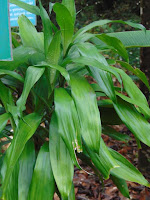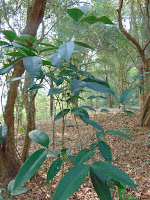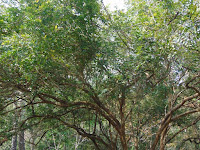It is cultivated tree in the tropical rainforest of some Southeast Asian nations like Indonesia, Malaysia, Sri Lanka, Philippines, and and its fruit is known as “the queen of fruits”. Its extract is used as antioxidant, antitumoral, antiallergic, anti-inflammatory, antibacterial, and antiviral activities.
Naringi crenulata
Malayalam Name(s): Dadhiphala, Kattunarakam, Mahavilvam, Malanarakam, Manmatham, Narinarakam, Serakuttunarakam, Vilathi.It is a flowering tree. Flowering season is June- December. It can be seen in the Semi-evergreen and moist deciduous forests, also in the plains of Palakkad, Kottayam, Kasaragode, Idukki, Malappuram, Kannur, Kozhikkode, Kollam, Thrissur, Wayanad districts of Kerala, India
 |
Mallotus philippensis
|
Mallotus philippensis
Kamala Tree, Red Berry, Monkey Face Tree, Kamala Dye Tree
Vernacular names : Bengali- Kamala; Hindi- Rohan,Sinduri, Raini. Rohini, Kamala,;Kannada- Kunkumada Mara, Kampillaka, Kunkuma- damara,; Malayalam-Ponnakam, Ponnagam, Naavatta, Sindooram , Kuramadakka, ,Kurangumanjas, Kunkuma ppuumaram, Pinoo,Kurangumanjal, Kapilam Kunkumam, Nuurimaram;
Marathi- Kapila,Kesari,Shendri; Sanskrit- Kampilyaka; Tamil-Kungumam,Kapila Poti, Kapli,
KuranguManjanathi,Kapili,Manjanai,Kanapotta,Kapilapodi,Kunnancholai,Kapila,Thirisalakkaai, Korangumanjanathi,Kamala,Konaspootoo,Thirisalakkaimaram,Kuranku-mañcanari,Thavattai; Telugu- Kunkuma-chettu
Mallotus philippensis is a tree in the spurge family. It is known as the kamala tree or red kamala or kumkum tree, due to the fruit covering, which produces a red dye. This kamala often appears in rain forest margins.
 |
Sapindus laurifolius
|
Sapindus laurifolius
soap berries or soap nuts
Malayalam Name: Uruvanchi
Sapindus laurifolius is a small trees in the Lychee family, Sapindaceae, native to warm temperate to tropical regions in both the Old World and New World. The genus includes both deciduous and evergreen species. Its fruit pulp is used to make soap. The generic name is derived from the Latin words sapo, meaning "soap", and indicus, meaning "of India"
 |
Cullenia exarillata
|
Cullenia exarillata
Wild Durian.
Vernacular names :
Malayalam-arayni Mullenpali, Vediplavu, Kurunguplavu, Alanki, Mullenchankka, Vedippala, Mullenpali Malai Konjil, anaipala,Kurunguplavu; Tamil-Polavu, Malai Kongi,Karanai, Velupla, Karayini, Vedipila, Karavi, Aini Pla, Vedu pla
An evergreen trees. Its frits are an important diet for the endangered species, lion tailed macaque
 |
Aporosa lindleyana
|
Aporosa lindleyana
Vernacular names :
Tamil: Kodali, Vettikan, Vettil, Vittil, Vitti.
Malayalam: Kodali, Kotili, Ponvetti, Vetti. Vittil.
Kannada: Salle mara, Sali, Sarali, Sulla.
It is a medicinal tree..AporosaLindleyana is commonly seen in western ghats, Sri Lanka and in some rain forests of Kerala. In Ayurveda Aporosa lindleyana is named as Kodali. The extract of its root is a very useful medicine. The name Aporosa lindleyana was given by a British Botanist John Lindley
 |
Cynometra travancorica
|
Cynometra travancorica
Malayalam name- Koori
Rare canopy tree grow in the wet
evergreen forests at an elevation between 200 - 700 m. Cynometra travancorica is a species of legume in the Fabaceae
family. It is a threatened species by habitat loss and found only in India.
 |
| Camthium pariflorum |
Camthium pariflorum
Malayalam name- Karamullu
A thorny shrub with spreading
branches. Leaves are small and simple. They are native to India, Sri Lanka,
eastern and southern Africa, Madagascar, Seychelles, China, Southeast Asia, New
Guinea, and some of the islands of the Pacific.
 |
| Cordyline fruticosa |
Cordyline fruticosa
Cabbage palm, good luck plant, palm lily
It is an evergreen flowering plant
in the Asparagus family, Asparagaceae. The green leaves are pointed, oval and
blade-shaped, about 4 inches wide and vary from 1 to 2 feet long. Cordyline fruticosa may have originated in tropical Asia and
Australia. A popular use of this plant was in making Okolehao, affectionately
called ‘Oke’, a potent liquor much like a clear brandy.
 |
| Garcinia xanthochymus |
Garcinia xanthochymus
Garcinia
Malayalam name- Vyrapuli / Rajapuli
Garcinia xanthochymus is a tree with a
rounded crown that grows from 4.5 to 7.6 m in height. Garcinia xanthochymus is native to northern India. The genus
Garcinia contains 240 species with a center of diversity in the Old World. Garcinia xanthochymus is cultivated
extensively in Southeast Asia where the fruit is made into preserves, jams, and
curries. The dried fruit sap is called gamboge and provides a dye that is used
in watercolor paints.
 |
| Flacourtia jangomas |
Flacourtia jangomas
Runealma Plum
Malayalam name- Vayyankatha
Runealma plum is a small, spiny,
evergreen tree that branches from very low down on the bole. It can grow up to
10 metres tall, but is usually smaller. The plant is cultivated, especially in
tropical Asia but also in Tropical America, for its edible fruit.
 |
| Memecylon randerianum |
Memecylon randerianum
Malayalam name- Kazhavu, Kaikkathetti, Koovachekki
This tree grows in evergreen and semi-evergreen
forests of Kerala, India, and also in sacred groves.
 |
| Bambusa vulgaris 'Wamin' |
Bambusa vulgaris 'Wamin'
Malayalam name- Budha belly
Bambusa vulgaris 'Wamin' or Dwarf
Buddha Belly Bamboo is a tropical and Habitat: Bambusa vulgaris 'Wamin' prefers
full sun to partial shade. If grown in deep shade, the nodes won't be as
pronounced, as the plant will stretch to reach for the sun. Although the roots
are cold hardy, the foliage is frost sensitive
It is an ornamental bamboo used in garden
landscaping or as erosion control. The culms are often used for handicrafts.
 |
| Dendrocalamus giganteus |
Dendrocalamus giganteus
Giant Bamboo or Dragon Bamboo
Malayalam name- Paramula
Dendrocalamus giganteus is a giant
tropical and sub-tropical clumping species native to Myanmar Bhutan, China and
Thailand. It is considered the tallest bamboo in the world. This bamboo species
produces a large amount of biomass. It can give an annual yield of 20 to 30
t/ha, which is 2.7 times more than that of Dendrocalamus latiflorus.
 |
| Diospyros candolleana |
Diospyros candolleana
Malayalam name- Chola karimaram
Diospyros candolleana, is a tree in the
Ebony family, endemic to the Western Ghats of India. Timber is hard, and used
in building constructions. A decoction of root-bark is used in rheumatism and
swellings in traditional medicine. The tree grows in wet evergreen forests.
 |
| Alangium salviifolium |
Alangium salviifolium
Malayalam name- Valli angolam
Alangium salviifolium is a
flowering plant in the Alangiaceae family. It is also commonly known as Ankolam
in Malayalam, Ankola in Kannada, Akola or Ankol in Hindi and Alanji in Tamil.
In India, It’s mostly found in dry regions in plains and low hills and also
found on roadsides. It’s native to Western Africa, Madagascar, Southern and
Eastern Asia (China, Malaysia, Indonesia, India, and Philippines), tropical
Australia, the western Pacific Ocean islands and New Caledonia
In Ayurveda the roots and the fruits
are used for the treatment of rheumatism and hemorrhoid. Externally, it is used
for the treatment of bites by rabbits, rats, and dogs. The root-bark is also
used in traditional medicine skin problems and as an antidote for snake bite.
Alstonia venenata
 |
Alstonia venenata
|
Common Name:Poison Devil Tree
Malayalam Name: analivegam
Sanskrit Name: Anadana
Tamil Name: Sinnappalai
Telugu Name: edaakula paala
Alstonia venenata (Poison Devil Tree) is a small tree growing up to 6 meters tall. The bark of Alstonia venenata is greyish brown. Leaves are simple. Flowers are white, occurring in clusters at branch ends. They are drought tolerant and hardy species once established.
Roots and fruits of Alstonia venenataare believed to be useful for skin diseases, leprosy, cobra and other venomous snake bites, epilepsy, fatigue, fever, syphilis, insanity, epilepsy etc.
Please click on the following blue coloured link to download high quality picture of Alstonia venenata.
https://drive.google.com/file/d/0BxtZ4KlAYDgGaTZHUTQyc0Jyclk/view?usp=sharing
Ficus Racemosa
 |
| Ficus Racemosa |
Botanical Name :
Ficus Racemosa
Common Names:
cluster fig, country fig, crattock, gular fig, redwood fig
Sanskrit Name:
audumbara, brahanvrkisha, gular, hemadugdhaka, jantukaphalah,
Hindi Name:
dumar, dharma patra, goolar, jantu phal, pani bhuj, pushp-hina
Malayalam Name:
aththi
Tamil Name:
anai, atti, malaiyin munivan, utumparam
Ficus Racemosa is a medium sized deciduous tree which shed its leaf for a period in August or September. Ficus Racemosa tree is an important food source for a variety of birds and animals.
In the herbal medicine, roots are used in treating, bark is good for gynaecological disorders. Fruits are useful in the treatment of leucorrhoea, blood disorders, burning sensation, fatigue, urinary discharges, leprosy, menorrhagia, epistaxis and intestinal worms.
Please click on the following link to download a high quality picture of Ficus Racemosa.
https://drive.google.com/file/d/0BxtZ4KlAYDgGRVN0alppYVREbjQ/view?usp=sharing
Bambusa multiplex
 |
| Bambusa multiplex |
Common Name: Hedge bamboo
Bambusa multiplex is an evergreen Bamboo growing to four meter. It can tolerate up to a-12 degree Celsius. Culms of Bambusa multiplex is used to make Paper. The canes are used as good poles. As the volume is less, canes are rarely used for pulp production. Canes can be split very easily and they are very flexible. Hence they are used to make baskets, mats etc.
Please click on the following link for downloading high quality picture of Bambusa multiplex:
https://drive.google.com/file/d/0BxtZ4KlAYDgGNEtDci1GSEI5cnM/view?usp=sharing
Wrightia Tinctoria
 |
| Wrightia tinctoria |
Botanical Name : Wrightia tinctoria
Common Name : Pala Indigo Plant, Sweet Indrajao,
Ivory wood
Sanskrit Name : Svetakutaja, Hayamaraka
Hindi Name : Duhi, Mitaindarjau Kapar
Malayalam Name : Dandappala, Ayyappala, Vettupala
Wrightia Tinctoria is a small deciduous tree that grows up to 10 meters and native to India and Burma. Wrightia is named after a Scottish physician and botanist William Wright.In herbal medicine the leaves are used in treating hypertension. Leaves, flowers and fruits are source of a kind of indigo called Pala-indigo.
Please click on the following link for downloading high quality picture of Wrightia tinctoria:
https://drive.google.com/file/d/0BxtZ4KlAYDgGWDg3b21KbGxCS2s/view?usp=sharing
Salacia fruticosa
Botanical Name: Salacia fruticosa
Malayalam Name: Ponkarandi, Eakanayakam
Salacia fruticosa, is a perennial herb endemic to Western Ghats, India. They are found in the evergreen and semi-evergreen forests, also in the sacred groves and plains. Flowering and fruiting season is February to May. Salacia fruticosa is an herb that has a long history of use as a treatment for diabetes in herbal medicine. Mugs made from salacia wood are used by people with diabetes to drink water.In addition to treating diabetes, salacia fruticosa is used for treating gonorrhea, asthma, itchiness, joint pain (rheumatism), obesity, thirst, and menstrual problems.
Please click on the following link to download a high quality picture of Salacia fruticosa.
Plumeria alba
 |
| Plumeria alba |
Common Names: caterpillar tree. pagoda tree, pigeon wood. Nosegay tree
Plumeria alba is a small tree known for is pungently fragrant, spiral shaped blooms typically produced from June through November.This tree has a thin bark and milky sap. Plumeria alba is often cultivated as an ornamental plant. flowers are edible and eaten as fritters, while the heart of the wood is part of a traditional medical preparation taken as a vermiform or as a laxative.
Please click on the following link to download high quality picture of plumeria alba:
https://drive.google.com/file/d/0BxtZ4KlAYDgGZlNOVWNzMGlJUm8/view?usp=sharing
Nardostachys jatamansi
 |
| Nardostachys jatamansi |
Common Names: Jatamansi ,Sambullateeb , Sumbul-ut-teeb , balchar
Malayalam Name : Jadamanji
Nardostachys jatamansi is a flowering plant of the Valerian family that grows in the Himalayas. It is a source of a type of intensely aromatic amber-colored essential oil,spikenard. The oil has, since ancient times, been used as a perfume, as a medicine and in religious contexts The plant has a rich history of medicinal use and has been valued for centuries in herbal medicines.
Please click on the following link to download a high quality picture of Nardostachys jatamansi:
https://drive.google.com/file/d/0BxtZ4KlAYDgGRk1KbzFGQklycTA/view?usp=sharing
Cinnamomum verum
 |
| Cinnamomum verum |
Common Name: “True cinnamon”, Sri Lanka, Ceylon cinnamon
Hindi Name: Dalchini
Tamil Name: Channalavangam, Karuva
Malayalam Name: Elavangam, Vayana
Kannada Name: Dalchini
Cinnamomum verum is native to South Asia, but had already been introduced pan-tropically in the 1700s. The fruit are eaten by birds and spread widely, and it has become invasive on Indian and Pacific Ocean islands, especially the Seychelles and Samoa. Once established, it becomes the dominant tree in moist mostly lowland tropical forests, and through competition can gradually affect the species richness of native forest, as the dense canopy shades out all other plants, creating species-poor stands that may cover large areas.. Another species Cinnamomum aromaticum, is less expensive and has a stronger flavor, is often marketed as “cinnamon,” Cinnamomum verum is generally considered to have a more delicate flavor that is more suitable for desserts. The names “cinnamon” and “cassia” cause considerable confusion, as they are often used interchangeably.
Please click on the following link to download high quality picture of cinnamomum verum:
https://drive.google.com/file/d/0BxtZ4KlAYDgGN2ViVDF6YjVsV2s/view?usp=sharing




























Comments